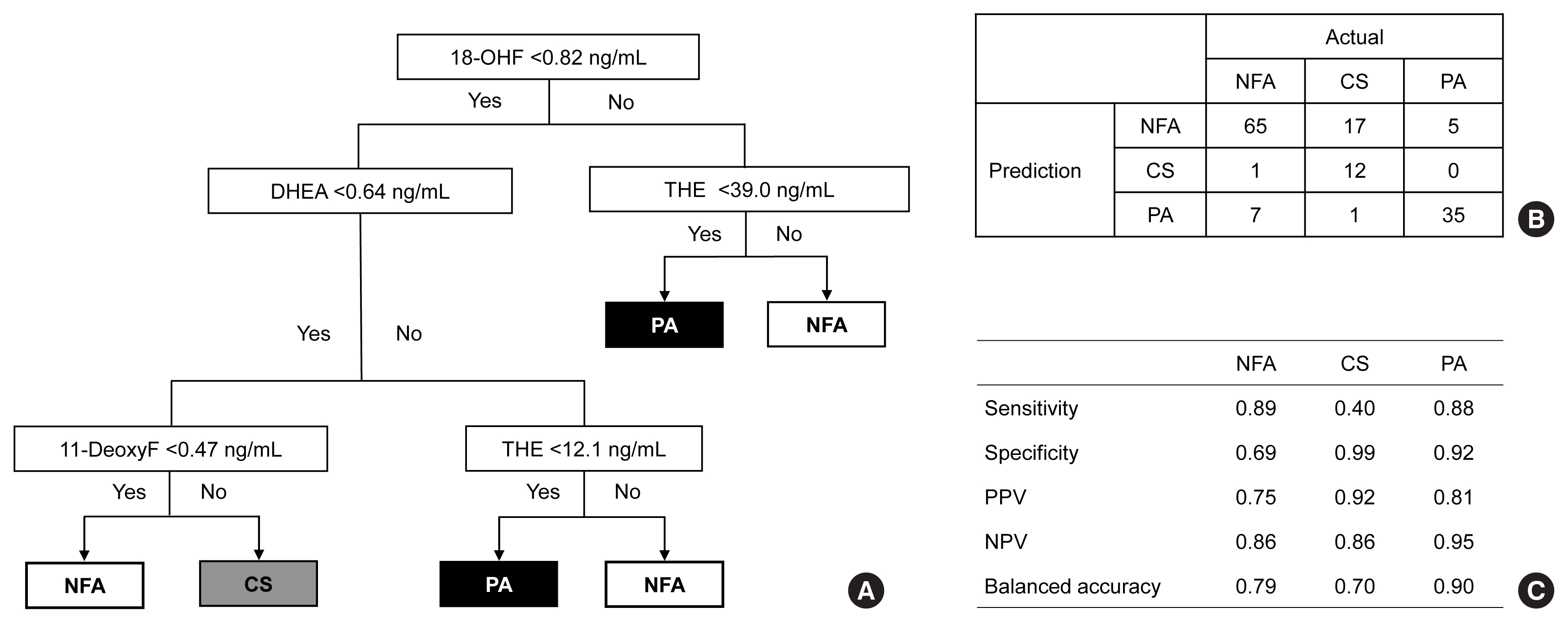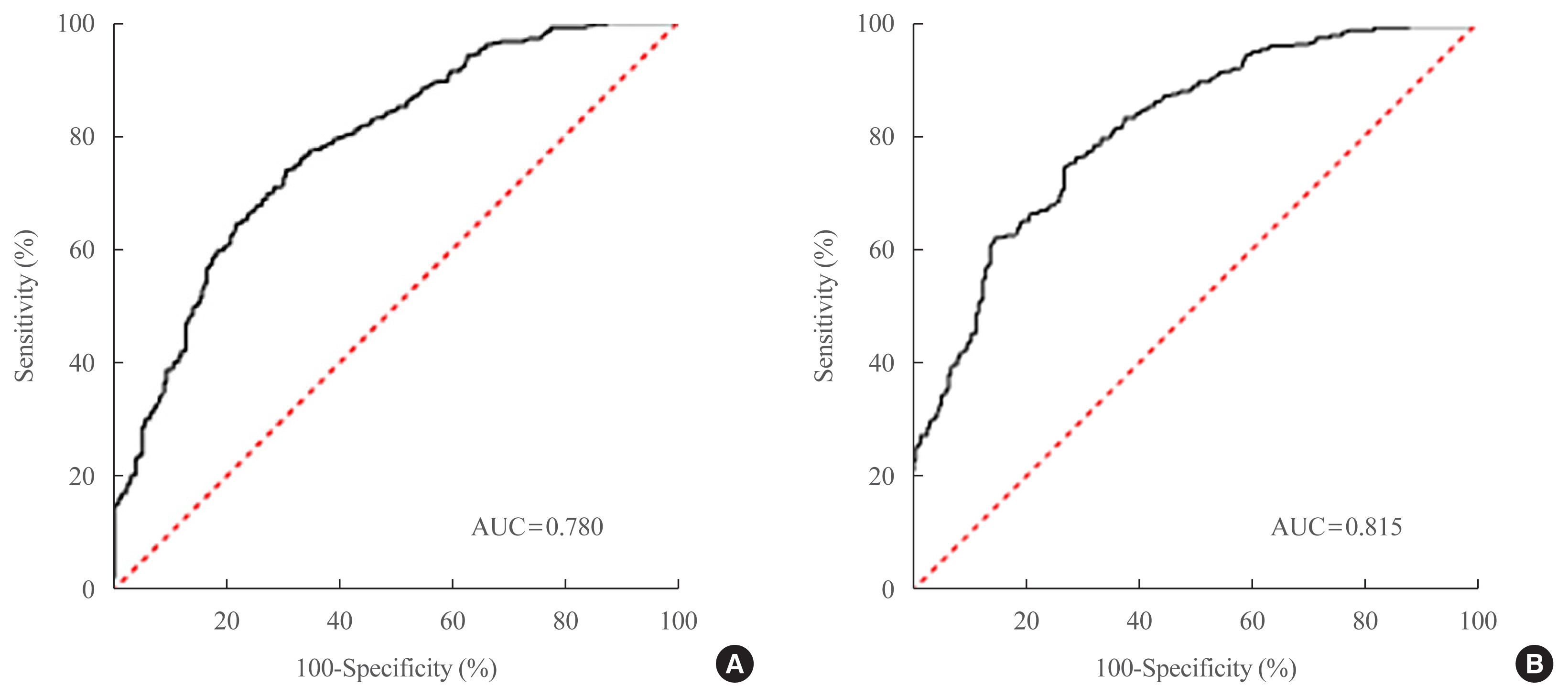- Adrenal Gland
- Metabolic Subtyping of Adrenal Tumors: Prospective Multi-Center Cohort Study in Korea
-
Eu Jeong Ku, Chaelin Lee, Jaeyoon Shim, Sihoon Lee, Kyoung-Ah Kim, Sang Wan Kim, Yumie Rhee, Hyo-Jeong Kim, Jung Soo Lim, Choon Hee Chung, Sung Wan Chun, Soon-Jib Yoo, Ohk-Hyun Ryu, Ho Chan Cho, A Ram Hong, Chang Ho Ahn, Jung Hee Kim, Man Ho Choi
-
Endocrinol Metab. 2021;36(5):1131-1141. Published online October 21, 2021
-
DOI: https://doi.org/10.3803/EnM.2021.1149
-
-
5,168
View
-
209
Download
-
9
Web of Science
-
10
Crossref
-
 Abstract Abstract
 PDF PDF Supplementary Material Supplementary Material PubReader PubReader  ePub ePub
- Background
Conventional diagnostic approaches for adrenal tumors require multi-step processes, including imaging studies and dynamic hormone tests. Therefore, this study aimed to discriminate adrenal tumors from a single blood sample based on the combination of liquid chromatography-mass spectrometry (LC-MS) and machine learning algorithms in serum profiling of adrenal steroids.
Methods
The LC-MS-based steroid profiling was applied to serum samples obtained from patients with nonfunctioning adenoma (NFA, n=73), Cushing’s syndrome (CS, n=30), and primary aldosteronism (PA, n=40) in a prospective multicenter study of adrenal disease. The decision tree (DT), random forest (RF), and extreme gradient boost (XGBoost) were performed to categorize the subtypes of adrenal tumors.
Results
The CS group showed higher serum levels of 11-deoxycortisol than the NFA group, and increased levels of tetrahydrocortisone (THE), 20α-dihydrocortisol, and 6β-hydroxycortisol were found in the PA group. However, the CS group showed lower levels of dehydroepiandrosterone (DHEA) and its sulfate derivative (DHEA-S) than both the NFA and PA groups. Patients with PA expressed higher serum 18-hydroxycortisol and DHEA but lower THE than NFA patients. The balanced accuracies of DT, RF, and XGBoost for classifying each type were 78%, 96%, and 97%, respectively. In receiver operating characteristics (ROC) analysis for CS, XGBoost, and RF showed a significantly greater diagnostic power than the DT. However, in ROC analysis for PA, only RF exhibited better diagnostic performance than DT.
Conclusion
The combination of LC-MS-based steroid profiling with machine learning algorithms could be a promising one-step diagnostic approach for the classification of adrenal tumor subtypes.
-
Citations
Citations to this article as recorded by  - Treating Primary Aldosteronism-Induced Hypertension: Novel Approaches and Future Outlooks
Nathan Mullen, James Curneen, Padraig T Donlon, Punit Prakash, Irina Bancos, Mark Gurnell, Michael C Dennedy
Endocrine Reviews.2024; 45(1): 125. CrossRef - Steroid profiling in adrenal disease
Danni Mu, Dandan Sun, Xia Qian, Xiaoli Ma, Ling Qiu, Xinqi Cheng, Songlin Yu
Clinica Chimica Acta.2024; 553: 117749. CrossRef - Plasma steroid profiling combined with machine learning for the differential diagnosis in mild autonomous cortisol secretion from nonfunctioning adenoma in patients with adrenal incidentalomas
Danni Mu, Xia Qian, Yichen Ma, Xi Wang, Yumeng Gao, Xiaoli Ma, Shaowei Xie, Lian Hou, Qi Zhang, Fang Zhao, Liangyu Xia, Liling Lin, Ling Qiu, Jie Wu, Songlin Yu, Xinqi Cheng
Endocrine Practice.2024;[Epub] CrossRef - Mild autonomous cortisol secretion: pathophysiology, comorbidities and management approaches
Alessandro Prete, Irina Bancos
Nature Reviews Endocrinology.2024;[Epub] CrossRef - Serum and hair steroid profiles in patients with nonfunctioning pituitary adenoma undergoing surgery: A prospective observational study
Seung Shin Park, Yong Hwy Kim, Ho Kang, Chang Ho Ahn, Dong Jun Byun, Man Ho Choi, Jung Hee Kim
The Journal of Steroid Biochemistry and Molecular Biology.2023; 230: 106276. CrossRef - Recent Updates on the Management of Adrenal Incidentalomas
Seung Shin Park, Jung Hee Kim
Endocrinology and Metabolism.2023; 38(4): 373. CrossRef - LC-MS based simultaneous profiling of adrenal hormones of steroids, catecholamines, and metanephrines
Jongsung Noh, Chaelin Lee, Jung Hee Kim, Seung Woon Myung, Man Ho Choi
Journal of Lipid Research.2023; 64(11): 100453. CrossRef - 2023 Korean Endocrine Society Consensus Guidelines for the Diagnosis and Management of Primary Aldosteronism
Jeonghoon Ha, Jung Hwan Park, Kyoung Jin Kim, Jung Hee Kim, Kyong Yeun Jung, Jeongmin Lee, Jong Han Choi, Seung Hun Lee, Namki Hong, Jung Soo Lim, Byung Kwan Park, Jung-Han Kim, Kyeong Cheon Jung, Jooyoung Cho, Mi-kyung Kim, Choon Hee Chung
Endocrinology and Metabolism.2023; 38(6): 597. CrossRef - Toward Systems-Level Metabolic Analysis in Endocrine Disorders and Cancer
Aliya Lakhani, Da Hyun Kang, Yea Eun Kang, Junyoung O. Park
Endocrinology and Metabolism.2023; 38(6): 619. CrossRef - Prevalence and Characteristics of Adrenal Tumors in an Unselected Screening Population
Ying Jing, Jinbo Hu, Rong Luo, Yun Mao, Zhixiao Luo, Mingjun Zhang, Jun Yang, Ying Song, Zhengping Feng, Zhihong Wang, Qingfeng Cheng, Linqiang Ma, Yi Yang, Li Zhong, Zhipeng Du, Yue Wang, Ting Luo, Wenwen He, Yue Sun, Fajin Lv, Qifu Li, Shumin Yang
Annals of Internal Medicine.2022; 175(10): 1383. CrossRef
- Diabetes, Obesity and Metabolism
- Non-Laboratory-Based Simple Screening Model for Nonalcoholic Fatty Liver Disease in Patients with Type 2 Diabetes Developed Using Multi-Center Cohorts
-
Jiwon Kim, Minyoung Lee, Soo Yeon Kim, Ji-Hye Kim, Ji Sun Nam, Sung Wan Chun, Se Eun Park, Kwang Joon Kim, Yong-ho Lee, Joo Young Nam, Eun Seok Kang
-
Endocrinol Metab. 2021;36(4):823-834. Published online August 27, 2021
-
DOI: https://doi.org/10.3803/EnM.2021.1074
-
-
4,477
View
-
138
Download
-
1
Web of Science
-
1
Crossref
-
 Abstract Abstract
 PDF PDF Supplementary Material Supplementary Material PubReader PubReader  ePub ePub
- Background
Nonalcoholic fatty liver disease (NAFLD) is the most prevalent cause of chronic liver disease worldwide. Type 2 diabetes mellitus (T2DM) is a risk factor that accelerates NAFLD progression, leading to fibrosis and cirrhosis. Thus, here we aimed to develop a simple model to predict the presence of NAFLD based on clinical parameters of patients with T2DM.
Methods
A total of 698 patients with T2DM who visited five medical centers were included. NAFLD was evaluated using transient elastography. Univariate logistic regression analyses were performed to identify potential contributors to NAFLD, followed by multivariable logistic regression analyses to create the final prediction model for NAFLD.
Results
Two NAFLD prediction models were developed, with and without serum biomarker use. The non-laboratory model comprised six variables: age, sex, waist circumference, body mass index (BMI), dyslipidemia, and smoking status. For a cutoff value of ≥60, the prediction accuracy was 0.780 (95% confidence interval [CI], 0.743 to 0.817). The second comprehensive model showed an improved discrimination ability of up to 0.815 (95% CI, 0.782 to 0.847) and comprised seven variables: age, sex, waist circumference, BMI, glycated hemoglobin, triglyceride, and alanine aminotransferase to aspartate aminotransferase ratio. Our non-laboratory model showed non-inferiority in the prediction of NAFLD versus previously established models, including serum parameters.
Conclusion
The new models are simple and user-friendly screening methods that can identify individuals with T2DM who are at high-risk for NAFLD. Additional studies are warranted to validate these new models as useful predictive tools for NAFLD in clinical
practice.
-
Citations
Citations to this article as recorded by  - Non-Alcoholic Fatty Liver Disease or Type 2 Diabetes Mellitus—The Chicken or the Egg Dilemma
Marcin Kosmalski, Agnieszka Śliwińska, Józef Drzewoski
Biomedicines.2023; 11(4): 1097. CrossRef
- Effect of 17-beta Estradiol on Adipocyte Lipin-1 Expression in OLETF Rat.
-
Eun Seok Kang, In Sook Kim, Seok Jin Ko, Chul Hoon Kim, Sung Wan Chun, Chul Woo Ahn, Bong Soo Cha, Hyun Chul Lee
-
Endocrinol Metab. 2010;25(3):199-205. Published online September 1, 2010
-
DOI: https://doi.org/10.3803/EnM.2010.25.3.199
-
-
2,016
View
-
21
Download
-
1
Crossref
-
 Abstract Abstract
 PDF PDF
- BACKGROUND
17 beta-estradiol is known to play an important role in glucose homeostasis. Lipin-1 is a nuclear protein that is essential in adipocyte differentiation and it is considered to play a role in ectopic fat deposition and the redistribution of fat. The aim of this study was to evaluate the effect of 17 beta-estradiol on the lipin-1 expression in the adipocytes of OLETF rats, which is an animal model of diabetes. METHODS: The OLETF rats were divided into 3 groups, 1) the sham-operation group (SHAM) 2) the castrated group (CAST) and 2) the castrated and estradiol treatment group (EST), and all the rats were at 6 weeks of age. LETO rats were used as a control group (LETO). 0.1 mg of estradiol valerate was injected subcutaneously every 4 weeks in the rats of the EST group. The visceral and subcutaneous tissues were isolated to evaluate the lipin-1 protein expression. The lipin-1 expression was measured in human visceral and subcutaneous preadipocytes. RESULTS: Less body weight gain was observed in the EST group compared with that of the SHAM group. In addition, improvement in the glucose tolerance was observed in the EST group. The lipin-1 expression in visceral fat was decreased in the SHAM and CAST groups, but it was but recovered in the EST group. The lipin-1 expression in the subcutaneous fat was decreased in the SHAM, CAST, and EST groups. CONCLUSION: Long term estradiol treatment in OLETF rats reduces the body weight gain and improves the glucose tolerance. Estradiol enhances the lipin-1 protein expression in the visceral adipocytes, but not in the subcutaneous adipocytes.
-
Citations
Citations to this article as recorded by  - Effect of 17-beta Estradiol on Adipocyte Lipin-1 Expression in OLETF Rat
Seong-Kyu Lee
Endocrinology and Metabolism.2010; 25(3): 177. CrossRef
- A Case of Familial Hypocalciuric Hypercalcemia Coexisting with Low Bone Mass.
-
Sung Wan Chun, Se Hwa Kim, Jong Yul Jung, Won Na Suh, Ji Ae Moon, Jong In Yook, Yoon Sok Chung, Yumie Rhee, Eun Jig Lee, Sung Kil Lim
-
J Korean Endocr Soc. 2006;21(6):583-588. Published online December 1, 2006
-
DOI: https://doi.org/10.3803/jkes.2006.21.6.583
-
-
 Abstract Abstract
 PDF PDF
- Familial hypocalciuric hypercalcemia is caused by heterozygous loss-of-function mutation of the calcium sensing receptor gene, and this is characterized by mild, persistently elevated levels of serum calcium without symptoms or complications. We present a case of clinically diagnosed familial hypocalciuric hypercalcemia with unexpected low bone mass. A 19-year-old man presented with incidentally discovered hypercalcemia. He showed normal growth and sexual maturation. Biochemical studies showed hypercalcemia, increased parathyroid hormone, hypocalciuria, a decreased urinary calcium-creatinine ratio and decreased serum 25-hydroxy-vitamin D. The other hormonal studies were normal. Dual energy x-ray absorptiometry showed low bone mineral density, and the Sestamibi scan showed no abnormality in the parathyroid glands. Iliac bone biopsy showed a general decrease in bone density and increased porosity of the cortical bone. Normal mineralization was also shown, but in part, osteoid deposition was also found. Direct sequencing of the patient's calcium sensing receptor gene showed a point mutation at exon7, Q926R.
- A Case of Autoimmune Hypoglycemia due to Insulin Antibody in Patient with End Stage Renal Disease.
-
Ji Ye Jung, Eun Seok Kang, Beom Seok Kim, Sung Wan Chun, Yumie Rhee, Chul Woo Ahn, Bong Soo Cha, Eun Jig Lee, Sung Kil Lim, Hyun Chul Lee
-
J Korean Endocr Soc. 2006;21(6):536-541. Published online December 1, 2006
-
DOI: https://doi.org/10.3803/jkes.2006.21.6.536
-
-
 Abstract Abstract
 PDF PDF
- Fasting hypoglycemia results from several mechanisms. Autoimmune hypoglycemia is one of the rare causes of hypoglycemia, and characterized by hyperinsulinemia, fasting hypoglycemia and the presence of autoantibodies to insulin or insulin receptor. We report here on a 64-year-old male patient with autoimmune hypoglycemia with end stage renal disease. He had no history of diabetes or insulin use. He had experienced several severe hypoglycemic events. The serum C-peptide level was 7.48 ng/mL and the insulin concentration was 115.4 micro U/mL when the fasting plasma glucose level was 88 mg/dL. The insulin to glucose ratio was 5.42, which suggested the presence of insulinoma. Yet the radiologic studies, including magnetic resonance cholangiopancreatography, endoscopic ultrasonography and selective calcium stimulated venous sampling revealed no evidence of insulinoma. The insulin autoantibody level was 62 micro U/mL. Therefore, we could diagnosis the autoimmune hypoglycemia. The hypoglycemia was treated with prednisolone and the patient recovered from this. His insulin level decreased to 21.11 micro U/mL and the insulin autoantibody level decreased to 34 micro U/mL. Hypoglycemia in the hemodialysis patients is not uncommon. One should bear in mind autoimmune hypoglycemia as one of the causes of hypoglycemia in patients with no history of diabetes.
|













